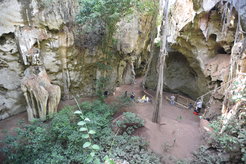Hunter-Trapper-Gatherers: People at Panga ya Saidi used Remote Capture Technology for Small Game
Researchers use animal bone remains from Panga ya Saidi, a cave in southeastern Kenya, to argue that people in the Middle and Later Stone Age used archaeologically invisible tools like snares, traps and nets to capture small game in forested environments
The Late Pleistocene (~125,000-12,000 years ago) is a critical period in the evolution of human behavior and cognition. Research into this period often focuses on human dispersals out of Africa into Eurasia and beyond, but a growing body of research is revealing more about the peoples, cultures and technologies of the African continent.

A recent study in the journal Quaternary Science Reviews is challenging ideas about hunter-gatherer behavior in the Middle and Later Stone Age, arguing that foragers at Panga ya Saidi regularly used remote capture tools such as traps, nets and snares to acquire small game from the site’s forested surroundings. The authors combine zooarchaeological data with published ethnographic and animal behavioral literature to challenge the frameworks that typically dominate eastern African archaeology, raising questions about labor division, prey selection, technology development and culinary practices.
The new study contradicts common conceptions of Stone Age subsistence, which often focus on big-game hunting in open grasslands. This image, the authors argue, is largely a result of biases in research that prioritize large, readily identifiable teeth, bones and horns recovered from a narrow set of environments in eastern Africa.
To arrive at these conclusions, an international team of researchers analyzed animal remains from Panga ya Saidi going as far back as 78,000 years ago, to the earliest signs of human occupation. After excluding microfauna likely deposited by other animal predators (small birds, mice, snakes, etc.) and looking for signs of human activity such as burning or butchery, the team was able to determine that people at Panga ya Saidi mainly consumed small bovids such as sunis, dik-diks and klipspringers. Larger species are also present, including wildebeest, buffalo and eland, but only become more frequent in periods when forests were receding.

The abundance of small, shy and solitary animals, combined with the diversity of species, indicates that the residents of Panga ya Saidi developed ways of capturing the smaller animals remotely, as opposed to encounter hunting with spear or bow and arrow. In other words, they trapped or ensnared them.
“Remote capture tools like snares and traps would have been made from materials that don’t last for tens of thousands of years. But by analyzing the bones left behind, and considering the ecological setting of the site and the behavior of the animal species represented, we can infer that people were using such tools,” says Mary Prendergast, a professor at Rice University who led the study.
Additionally, the authors argue, capturing prey remotely comes with several advantages that ancient peoples would have been likely to exploit. Although building and setting traps requires initial labor input, it later allows for more free time with more reliable returns than are often experienced in encounter hunting, particularly in the forested environment of Panga ya Saidi. Furthermore, the devices, whether traps, snares, nets or pitfalls, could be built, set and monitored by any member of the group: woman or man, elder or child.
“This study paves the way for future research to support or challenge the remote capture hypothesis and opens questions about the technological innovations and social lives of foraging peoples in the remote past,” says Jennifer Miller, coauthor and researcher at the Max Planck Institute of Geoanthropology. “We hope that future investigations will take a similar holistic approach and begin to address the biases that have impacted our understanding so far.”

